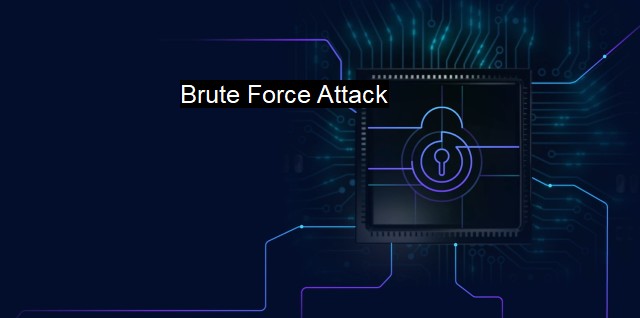What is Brute Force Attack?
Preventing Brute Force Attacks: Techniques and Strategies to Safeguard User Credentials and Data Privacy in Cybersecurity
Brute Force Attack in the context of cybersecurity is essentially a method used by hackers where they attempt to gain access to a system by guessing passwords until they achieve a correct guess. The term "brute force" is derived from the approach of the attack, which relies less on nuances and more on sheer computational power. It is a blunt yet effective method of bypassing cybersecurity defenses if no other protective counter-measures are in place.While there can be a level of algorithmic sophistication in optimizing how the guesses are made, at the most basic level, the brute force attack can simply involve an attacker systematically checking all possible combinations of passwords until the correct one is found. In theory, given unlimited time and resources, a brute force attack will always be able to eventually find the password.
In practice, time becomes a major limiting factor. Passwords that are more complex and longer length significantly expand the total number of possible combinations. For comparison, a password consisting only of 2-digit number have 100 possible combinations. Extend that to a 6 character-long mixture of alphanumeric characters, and the number of possibilities explodes to over 2 billion. Password complexity, although aggravating to many users, is an essential first step in protecting systems from brute force attacks.
Brute force attacks are not limited to just password guessing. Different instances can include attempts to break encryption, find hidden web pages, or even identifying unsecured points of entry in a network. Each of these forms involves a degree of blind testing and relentless persistence from cybersecurity threats.
Multi-factor authentication (MFA) and robust network encryption are critical measures in reducing the attack surface for brute force attempts. MFA creates layers of security mechanisms that require multiple conditions of entry; a system with properly implemented MFA cannot be compromised by password guessing alone.
Rate-limited login attempts, which cap the amount of password entries over a certain period, can curb brute force attacks effectively. This method doesn't entirely eliminate the risk of a brute force attack, but it does make it significantly more challenging by extending the conceivable time it would take to guess a password correctly.
Despite these threats, there are some merits to brute force attacks. Chiefly, vulnerability assessment and penetration testing sometimes require the usage of the brute force approach. In these cases, the brute force attack acts as a tool under the controlled circumstances to find potential weaknesses in a system.
It is crucial to recognize the importance of antivirus software as well, in relation to brute force attacks. Quality antivirus software often comes with a feature that monitors the number of failed access attempts during a specified amount of time. When the number breaches a certain threshold, the account is temporarily or permanently locked.
It's not just device security that antivirus software can protect against brute force attacks. Some antivirus software has evolved to include protection for online accounts, alerting users to attempted unauthorized access.
While brute force attacks are a substantial threat in the cybersecurity space, a mixture of complexity and diversity of security mechanisms, along with rigid password policies, can significantly increase the difficulty for these attempts at intrusion. no system is entirely invulnerable, but every step towards stronger security forces potential attacks to expend more of their resources, reducing their feasibility and effectiveness in a real-world security scenario. The ability to detect and defend against brute force attacks is a fundamental aspect of any serious cybersecurity strategy.

Brute Force Attack FAQs
What is a brute force attack?
A brute force attack is a type of cyber attack where hackers use automated tools to try every possible password or encryption key to gain unauthorized access to a system.How does a brute force attack work?
In a brute force attack, hackers use software that automatically generates a large number of passwords or encryption keys and tries them one by one until the correct one is found. This process can take a long time, but with enough computing power, hackers can crack even the most complex passwords.How can I protect myself from a brute force attack?
To protect yourself from a brute force attack, it's important to use strong and unique passwords, avoid using the same password across multiple accounts, and enable two-factor authentication whenever possible. You can also use antivirus software and firewall to prevent brute force attacks.What are some signs that my system has been targeted by a brute force attack?
Some signs that your system may have been targeted by a brute force attack include a high number of failed login attempts, unusual user activity, and slow performance. If you suspect that your system has been targeted, it's important to take immediate action to limit the damage and prevent any further attempts.| | A | | | B | | | C | | | D | | | E | | | F | | | G | | | H | | | I | | | J | | | K | | | L | | | M | |
| | N | | | O | | | P | | | Q | | | R | | | S | | | T | | | U | | | V | | | W | | | X | | | Y | | | Z | |
| | 1 | | | 2 | | | 3 | | | 4 | | | 7 | | | 8 | | |||||||